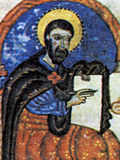Movses Kaghankatvatsi
You can help expand this article with text translated from the corresponding article in Armenian. (March 2020) Click [show] for important translation instructions.
|
Movses Kaghankatvatsi (
The History of the Country of Albania (Պատմութիւն Աղուանից Աշխարհի, Patmutʿiwn Ałuanicʿ Ašxarhi).[1][2][3][4]
Authorship
The first historian to mention Movses' work was the medieval Armenian legal scholar Mkhitar Gosh, referring to him as "Movses Daskhurantsi."[5] A later historian, Kirakos Gandzaketsi, referred to a statement in the History itself, to attribute the name of the author as Movses Kaghankatvatsi. The statement in question (Book II, ch. 11) says:
When the enemy became aware of what had happened, they pursued them and overtook a group of them at the foot of the mountain opposite the large village of Kaghankatuik, which is in the same province of Uti where I too am from.
Movses narrates the
Partav
in the tenth century.
Because of such time lapse and difference in style, attribution of the work to a single author seems doubtful. For this reason it has been common to assume two consecutive authors or editors,
Kaghankatvatsi (7th century) as the author of Books I and II, and Daskhurantsi (tenth century) as the editors of Kaghankatvatsi's text and the author of Book III.[5]
Publications and translations
Grabar (Old Armenian)
- Movses Kaghankatvatsi (1983). History of Aghuank in original Old-Armenian (Մովսէս Կաղանկատուացի.Պատմութիւն Աղուանից աշխարհի), critical text and introduction by Varag Arrakelian (in Armenian). Yerevan: "Matenadaran" Institute of old manuscripts after Mesrob Mashtots. Armenian SSR Academy of Sciences.
Russian translation
- Movses Kaghankatvatsi (1984). The History of the Country of Aluank (translated by Š.V. Smbatian) (in Russian). Yerevan: Matenadaran.
Georgian translation
- Movses Kaghankatvatsi (1985). The History of Albania (translated by L. Davlianidze-Tatishvili) (in Georgian). Tbilisi.
{{cite book}}: CS1 maint: location missing publisher (link)
English translations
- Movsēs Dasxuranc'i (1961). The History of the Caucasian Albanians (translated by C. F. J. Dowsett). London: (London Oriental Series, Vol. 8).
- Movsēs Dasxuranc'i (2010). The History of the Aghuans (translated by R. Bedrosian). New Jersey.
{{cite book}}: CS1 maint: location missing publisher (link)
References
- ISBN 0-924171-50-2.
The tenth century A.D. Armenian historian Movses Kalankatuatsi states that ...
- ^ (in German) Gesellschaft, Görres. Oriens Christianus. Leipzig, Germany: O. Harrassowitz 1905, p. 274
- ^ Encyclopædia Iranica, Arran
- ISBN 0-86078-992-6.
- ^ ISBN 0-8143-3023-1.
- ^ Hewsen, Robert H. (1964). Notes and Communications. London: Bulletin of Oriental and African Studies, University of London vol. 27. pp. 151–156.

